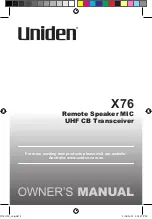
•
Modbus TCP is used with local TCP sessions on slave sites or when combination of Modbus RTU
and Modbus TCP is used. For more information refer to Application note Modbus TCP/RTU
2
This
applies also to other SCADA protocol TCP versions, e.g. DNP3 TCP.
Important
The TCP (UDP) session operates only locally between the RipEX and the central computer,
hence it does not increase the load on Radio channel.
In some special cases, the Terminal server can be also used for reducing the network load from applic-
ations using TCP. A TCP session can be terminated locally at the Terminal server in RipEX, user data
extracted from TCP messages and processed like it comes from a COM port. When data reaches the
destination RipEX, it can be transferred to the RTU either via a serial interface or via TCP (UDP), using
the Terminal server again.
•
Terminal server
List box: On, Off
Default = Off
If
On
, up to 5 independent Terminal servers can be set up. Each one can be either of TCP or UDP
Type
,
Inactivity
is the timeout in sec for which the TCP socket in RipEX is kept active after the last
data reception or transmission,
My IP
address of a Terminal server has to be always the same as
the IP address of the RipEX ETH interface,
My Port
can be set as required.
Destination IP
and
Destination port
values belong to the locally connected application (e.g. a virtual serial interface).
In some cases, applications dynamically change the IP port with each datagram. In such a case
set Destination port=0. RipEX will then send replies to the port from which the last response was
received. This feature allows to extend the number of simultaneously opened TCP connections
between a RipEX and locally connected application to any value up to 10 on each Terminal server.
Protocol
follows the same principles as a protocol on COM interface. You may tick/untick each in-
dividual Terminal server in order to make it
active
/
inactive
.
Note: Max. user data length in a single datagram processed by the Terminal server is 8192 Bytes.
TCP proxy*
Compared to UDP, the TCP protocol generates more load (longer headers, extra handshake datagrams),
which in some circumstances may significantly reduce the user data throughput in a narrowband radio
modem network. The TCP proxy module converts TCP to UDP (and vice-versa) so that only UDP da-
tagrams are transferred over the Radio channel. TCP sessions are maintained only locally between
the end RipEX and the connected application device (at both ends of the RipEX network).
Note
The TCP proxy module is activated and configured independently in each end RipEX.
To successfully handle an end-to-end application TCP session, the two respective end
1.
RipEXes have to be configured properly to match the same destination and source
address/port pairs.
2.
Some applications use the TCP session status or handshake datagrams (TCP ACK)
RTT for important decisions at the application level. It is not recommended to use TCP
proxy with such applications, since the status of the local TCP sessions at the respective
ends of the RipEX network is not synchronized. It is also highly recommended to use
TCP proxy only with the ACK setting „On“ (Settings/Device/Operating mode). Neverthe-
2
http://www.racom.eu/eng/products/m/ripex/app/modbus.html
113
© RACOM s.r.o. – RipEX Radio modem & Router
Advanced Configuration
Содержание RipEX 1.12.2
Страница 2: ......
Страница 172: ...RipEX Radio modem Router RACOM s r o 172 Safety environment licensing...
Страница 173: ...173 RACOM s r o RipEX Radio modem Router Safety environment licensing...
Страница 174: ...Fig 10 2 ATEX Certificate RipEX RipEX Radio modem Router RACOM s r o 174 Safety environment licensing...
Страница 175: ...175 RACOM s r o RipEX Radio modem Router Safety environment licensing...
Страница 176: ...RipEX Radio modem Router RACOM s r o 176 Safety environment licensing...
Страница 186: ...186...
Страница 187: ...Appendix C Revision History 187 RACOM s r o RipEX Radio modem Router Revision History...
















































